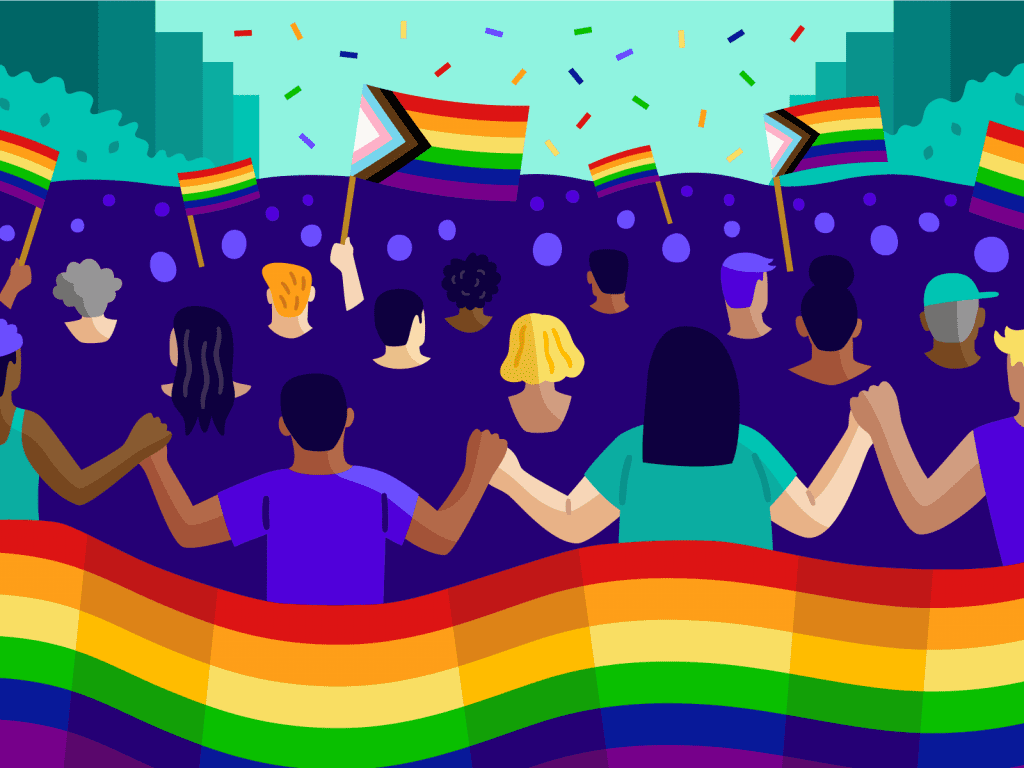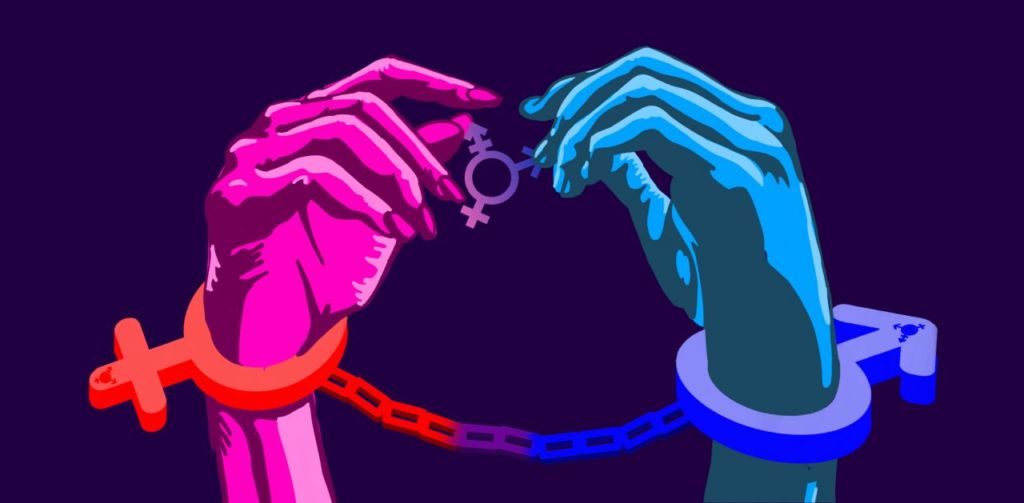
As per the data submitted by the government to the Supreme Court, it was calculated that there were about 2.5 million LGBTIQ population in India, as of 2012. Since then, the population has been on the rise. Coming out of the illusion of a ‘binary world’, there have been some vociferous demands for equal rights. It is submitted that beyond the man-woman binary, there are as many as 58 gender variants. All of this has called for some serious consideration to be given to this issue.
As there has been a gradual shift from public morality to constitutional morality, our judiciary has been an active advocate of LGBTIQ rights. In a plethora of judgments, efforts have been made in this direction. Our state has also been making some significant efforts in this direction.
Right to Self-Identity

The first step in forging the path for queers is legally recognizing them as belonging to a distinct identity and this was achieved in India in 2014.
2014 marks a watershed moment in the history of the fight for LGBTIQ rights in India. For the first time, in the case of National Legal Services Authority v. Union of India, the apex court recognized the category of “third gender”. In this judgment, the honorable court deliberated on the issue of whether non-binary people who did not fit into rigid male-female molds have a right to be identified as the ‘third gender’ and whether not recognizing the same would violate their fundamental rights. The state governments were also directed to develop mechanisms for recognizing and realizing the rights of the ‘third gender’.
It was upheld that all persons had the right to self-identify themselves as belonging to the third gender. Moreover, this categorization would not be based upon biological factors, rather on people’s ‘innate perception’ of their gender. This also implies that subjecting any person belonging to the third gender to any medical examination or biological test would violate their privacy. Jurisprudentially, this case is an important stepping stone in expanding the scope of our fundamental rights and securing the interests of all our citizens. Honorable justices delved deeper into the concept and scope of “gender identity” as a means of ‘self-expression’ and bringing the same under the ambit of ‘dignity’ safeguarded by Article 21.
It was also noted that the Right to Equality under Article 14 and Freedom of expression under Article 19(1) of the Constitution of India extends to all the people in India, irrespective of their gender. This means that the people belonging to the ‘third gender’ have the right to be treated equally and to express themselves in a way that suits them. It was interpreted that Article 15 prohibits discrimination based on ‘sex’ and ‘sex’ here not only implies the biological features but includes ‘gender’, i.e. one’s self-perceived identity. Thus, Part III of the Indian Constitution equally protects the rights of the ‘third gender’ and is entitled to lead a normal life like anyone else. The essence of Human Rights was also notably mentioned.
The honorable court observed that there was a need of diffusing knowledge in the social environment and this requires the efforts of our governments at the center and state to organize requisite programs. It also directed the government to legally recognize the ‘third gender’ in all necessary official documents and outline social welfare programs for them. Additionally, the third gender was to be included in the category of “socially and educationally backward” class of citizens so as to make them beneficiaries of reservations in educational institutions and in employment for empowerment.
This was the beginning of legal recognition and state protection benefits for the LGBTIQ people in India.
Does the LGBTIQ Population have Right to Privacy?

After securing legal recognition, another milestone was winning the right to privacy. The KS Puttaswamy v. Union of India judgment recognized the right to privacy as a fundamental right which came as a boon for all the citizens of India, especially for the third gender.
Despite getting legal recognition, the life of the ‘third gender’ did not turn upside down overnight. It was still a battle for them to live a life of dignity. Section 377 of IPC still criminalized homosexuality. They might have won recognition in the public space, but their personal space was still scrutinized and held with contempt and ridicule. The concept of ‘privacy’ was still alien to them. The Puttaswamy judgment was a breakthrough in the fight for LGBTIQ rights.
Justice Chandrachud enunciated that sexual orientation is an important facet of privacy and hence deserves protection. Thus, any discrimination or violation of this injures a person’s dignity and self-worth, and hence demands protection. Privacy is all about personal choices relating to one’s lifestyle. Despite the NALSA judgment, this facet was largely ignored. “Sex changing therapies” and other such tests and examinations are being conducted in the public domain. All of this amounts to invading their privacy. The Puttaswamy judgment has strengthened the protection provided to the ‘third gender’ by the NALSA judgment. In many cases where homosexuals leave their families and homes to live with their partners, habeas writs were misused to prevent them from doing this. Now with the protection of privacy, homosexuals can be saved from this ordeal. Also, this judgment seeks to protect a person’s privacy in public spaces which is an important element of one’s dignity.
Justice Nariman outlined three main aspects of privacy- (a) personal privacy of body and movement, (b) informational privacy, and (c) privacy of personal choices. These privacies are granted to everyone and have special significance for the third gender. Their autonomy pertaining to their bodies and personal choices has long been denied. Now this being safeguarded as a fundamental right, it was yet another significant achievement for them.
Decriminalising Section 377

Carrying forward the colonial legacy of oppression, Section 377 of the Indian Penal Code criminalized homosexuality and denied an important right to the members of the LGBTIQ community. This was finally corrected in 2018. But the fight for the same goes back to several years before.
The legal battle commenced in 2001 when several LGBTIQ rights NGOs filed a petition to decriminalize Section 377. Again, in 2006 a national AIDS control body filed an affidavit in the support of the petition citing that Section 377 hampered the efforts to prevent AIDS infection. Finally in 2007, in the case of Naz Foundation vs. Govt. of NCT Delhi, Delhi HC held Section 377 unconstitutional on the ground that it violated Articles 14, 15, and 21 of the Indian Constitution.
However, this decision was overturned in Suresh Kumar Koushal vs. Naz Foundation in 2013 by the honorable SC. It was observed that to change such laws was the responsibility of the parliament and it was a minuscule population that was prosecuted under this section. Finally in 2018, in the case of Navtej Singh Johar v. Union of India, SC struck down Section 377 as being unconstitutional. This judgment since then has become a symbol of ‘Pride’ for the entire LGBTIQ community.
The court held that Section 377 put an unreasonable restriction on the freedom of expression and someone’s sexual conduct in private did not hurt any social standards of ‘decency and morality’. Interfering in ‘consensual intimacy between two adults in private’ amounts to violating their right to dignity and privacy protected by Article 21. Acting as the stalwart of fundamental rights of the citizens, honorable SC gave an unprecedented paradigm of transformative constitutionalism by recognizing the rights of the LGBTIQ community.
Legislations in Place for LGBTIQ

The Transgender Persons (Protection of Rights) Act, 2019 is the most recent and effective legislation that seeks to protect the rights of the LGBTIQ community. Though the Act is not perfect and contains some contentious provisions, it marks a fairly good beginning to realize the rights of the community.
The Act for the first time establishes a clear definition of the word ‘transgender’. It also prohibits discrimination against transgenders at educational institutions, employment opportunities, healthcare facilities, and access to public services and benefits. The rights of transgender people of movement, property, and holding public and private offices are also highlighted. It is established that all transgenders must be treated equally without any discrimination.
In every establishment, there must also be a ‘Complaint Officer’ to register complaints from transgender employees. The Act has also made a provision for the issuance of an ‘Identity Certificate’ to manifest the right to self-perceived identity. There is also a provision for the establishment of the National Council for Transgender Persons to assist the government in policy formulations for the benefit of transgenders. It has also directed the government to set up special medical facilities and AIDS surveillance centers. Engaging transgenders in bonded labor, denial of access to public places, subjecting them to emotional or sexual abuse, and several other offenses against transgender persons have been made punishable offenses.
Conclusion
The Indian mechanism for realizing LGBTIQ rights has been currently limited to activist alleys, judicial decisions, and some partially effective state efforts. There has been an active protest among various LGBTIQ groups and organizations. Social media has been particularly an important platform for people to come out of the closet. Our judiciary has also been an active supporter of granting equal rights to the LGBTIQ community, furthering the agenda of promoting constitutional morality and taking light away from public morality. The state has made some notable efforts in realizing the rights.
However, these efforts fail to hit the nail on the head. The Act of 2019 contains some serious deficiencies. Though homosexuality has been decriminalized, such couples do not have marriage and adoption rights yet. The LGBTIQ community still does not have permission to enter the military. It is unfortunate that the same has not percolated deep enough into the social fabric. As per Equaldex, on a scale of 100, public opinion in India about LGBTIQ rights scores a meager 47. The social acceptance of the community has not reached favorable levels. What seems to be required now is making the laws more effective and equal; and spreading awareness in society. Thus, the work of forging a path for the queers has been ‘In progress’ in India, to say the least.